SEO forecasting might seem like a shot in the dark sometimes, but stick with me. Mastering this skill could make the difference between scraping by and scaling up.
What SEO Forecasting Really Means for Your Agency
We’ve all sat across from potential clients, promising big SEO results. Sometimes, those promises led to overpromising and underdelivering. It’s a tough cycle to break.
Enter solid SEO forecasting. This isn’t about guesswork or gut feelings. Use hard data to make educated predictions and set realistic expectations. Consider it your edge in a world where every agency claims to be the best.
5 Ways Forecasting Will Revolutionize Your Agency
Check out these tangible benefits for your agency:
- How to Win More Pitches: Walk into a pitch meeting with a forecast showing potential traffic increases, lead generation estimates, and projected revenue growth. You’re not just talking; you’re presenting a roadmap to success. This concrete value proposition makes clients pay attention.
- Build Trust in a World of Skeptics: Clients today are more skeptical than ever. Many have been burned by agencies promising quick fixes and overnight success. Share your forecasts to demonstrate transparency. Tell them, “Here’s what we think will happen, and here’s why.” Open communication and realistic expectations start on day one.
- Work Smart, Not Just Hard: How often have you tried everything, hoping something would work? Forecasting allows you to focus your efforts where they’ll have the biggest impact. Be strategic with your time and resources. Don’t just stay busy; be effective.
- Justify Your Fees with Hard Data: Budget discussions can be dread-inducing. Solid forecasts give you more than just your track record. Show potential ROI in black and white. Make it harder for clients to argue when you demonstrate how your work directly impacts their bottom line.
- Stay One Step Ahead of Google: Sudden algorithm updates can throw strategies into chaos. While predicting every change is impossible, forecasting helps spot trends for quick adaptation. Stay proactive, not reactive.
Key Ingredients for Successful SEO Forecasting
Great forecasts aren’t wild guesses. They’re built on solid foundations. Let’s explore what makes SEO forecasting truly effective.
Make Client Goals Your Top Priority
Skip the assumptions about what success means to your client. Dig deep into their objectives. Uncover their sleepless nights, success definitions, and priority SEO metrics. Brand awareness or direct sales? Short-term wins or long-term growth? Get the full picture.
Craft a goal worksheet for your kickoff meetings. Structure the conversation and lock in expectations from day one.
Here’s a template to kickstart your process:
| Timeframe | Traffic Goal | Conversion Goal | Revenue Goal | Key Performance Indicators |
|---|---|---|---|---|
| 3 Months | ||||
| 6 Months | ||||
| 1 Year |
Probe into risk tolerance, seasonal factors, and available internal resources. These insights sharpen your forecast accuracy and achievability.
Find the Right Data
Today’s data-rich environment demands focus. Zero in on Google Analytics, Search Console data, and at least 12 months of historical performance. Add competitor insights from Semrush or SE Ranking, plus industry benchmarks.
Quality trumps quantity. Clean, reliable data leads to solid forecasts. Audit those Google Analytics setups – you’d be surprised how often they’re off.
Conduct a thorough Google Analytics check. Verify tracking codes, goal setups, and e-commerce configurations. Hunt for data gaps or anomalies that could throw off your predictions.
Mine Search Console for golden nuggets. Identify high-impression, low-click keywords. These reveal quick-win opportunities to boost your forecast accuracy.
Study The Competitors
As Sun Tzu said,
If you know the enemy and know yourself, you need not fear the result of a hundred battles.
While dramatic, this quote is spot on for SEO. Examining your client’s competitive landscape is crucial for accurate forecasting.
Channel your inner Sun Tzu. Know your client’s SEO battlefield inside and out. Semrush and SE Ranking are your reconnaissance tools. Answer these critical questions:
- Who dominates the niche?
- Which competitor keywords are your client missing?
- How do rival content strategies stack up?
- What’s the lay of the backlink land?
Create a SWOT analysis from your findings. Pinpoint realistic competition areas and potential domination zones for your client.
Tailor Your Approach to Each Industry
B2B software and local restaurants need different SEO playbooks. Master the customer journey, seasonal swings, and industry-specific search behavior. Know the typical conversion rates and key metrics that matter.
Build industry-specific playbooks over time. They’ll fast-track your understanding of new clients’ unique challenges. Check out how forecasting shifts across industries:
| Industry | Key Considerations |
|---|---|
| E-commerce | Product category rankings, seasonal spikes, conversion rate, average order value |
| B2B Services | Lead quality focus, extended sales cycles, thought leadership content impact |
| Local Businesses | Local pack rankings, community events influence, call and direction request tracking |
| Healthcare | YMYL guidelines adherence, E-A-T signal optimization, extended research phase allowance |
Keep Up with SEO Changes
SEO never stands still. Google algorithms evolve, new competitors emerge, and user behavior shifts. Don’t let your forecasts become outdated. Set regular review periods, be upfront with clients about the need for flexibility, and have backup plans for major algorithm changes.
Create an “Algorithm Update Action Plan.” Assign roles to your team, outline quick analysis steps, and prepare client communication templates. Be ready to adjust your strategies when Google makes changes.
Accuracy isn’t everything. Being able to adapt and communicate clearly with clients is what matters most. Keep up with SEO trends, be honest about possible changes, and watch your client trust and the value of your forecasts increase.
SEO Forecasting Methods That Work
Time to roll up our sleeves and get practical. These forecasting methods work in the real world. We’ll show you how specific tools can supercharge your forecasting game while covering general principles.
Use Semrush for Keyword Forecasts
Keyword-level forecasting is the cornerstone of SEO predictions. Here’s how to ace it using Semrush:
1. Deep Keyword Research
Tap into Semrush’s Keyword Magic Tool to uncover hidden gem keywords. Go beyond the obvious high-volume terms. Find long-tail opportunities, question-based queries, and “shoulder” keywords (those closely related to your main keywords) your competitors might miss. SEMrush serves up comprehensive data on search volume, keyword difficulty, and CPC.
Their new integration with AI uses the Topical Authority of the domain’s content in relation to the analyzed keyword to fine-tune accuracy when it comes to Keyword Difficulty, relevance, and potential positions.
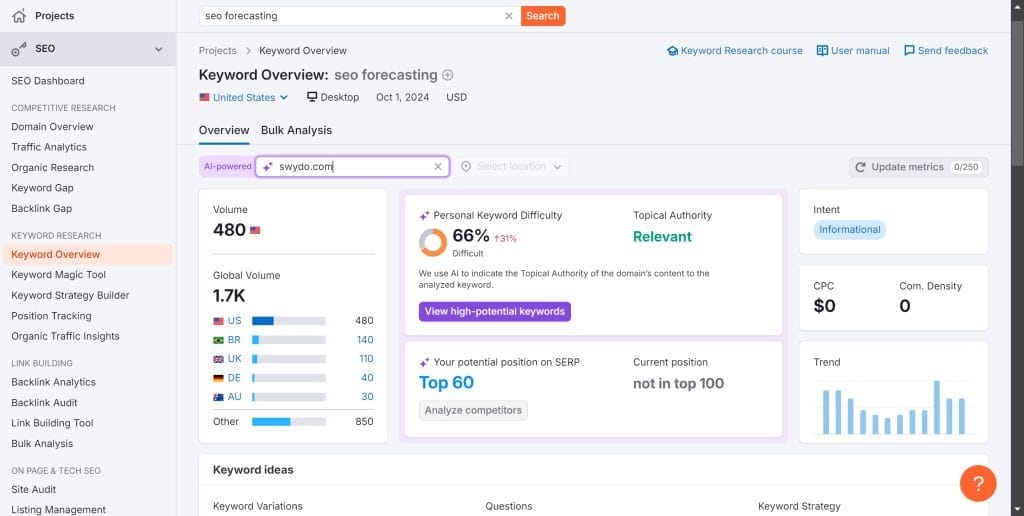
2. Laser-Focus Your Data:
For each keyword, grab:
- Search volume (straight from Semrush )
- Current ranking (Semrush ‘s Position Tracking tool has your back)
- Estimated CTR based on position (Semrush’s Organic Research tool nails this)
- Conversion rate (if you’ve got historical data)
3. Outsmart the Competition:
Use Semrush’s Keyword Gap tool to stack your keyword strategy against competitors. Spot opportunities they’re sleeping on.
4. Crunch the Numbers:
For each keyword, calculate:
- Potential Traffic = Search Volume * Estimated CTR
- Potential Conversions = Potential Traffic * Estimated Conversion Rate
5. Sanity Check:
Trust your gut. If your forecast shows a jump from 0 to 10,000 visitors overnight, it’s time to double-check those numbers.
Pro Tip: Organize your keywords into groups with Semrush’s Keyword Manager. It’ll make analysis and forecasting a breeze.
Improve Forecasts with SE Ranking
SE Ranking’s SEO Potential tool helps estimate the outcome of your SEO efforts.
Here’s how to use it effectively:
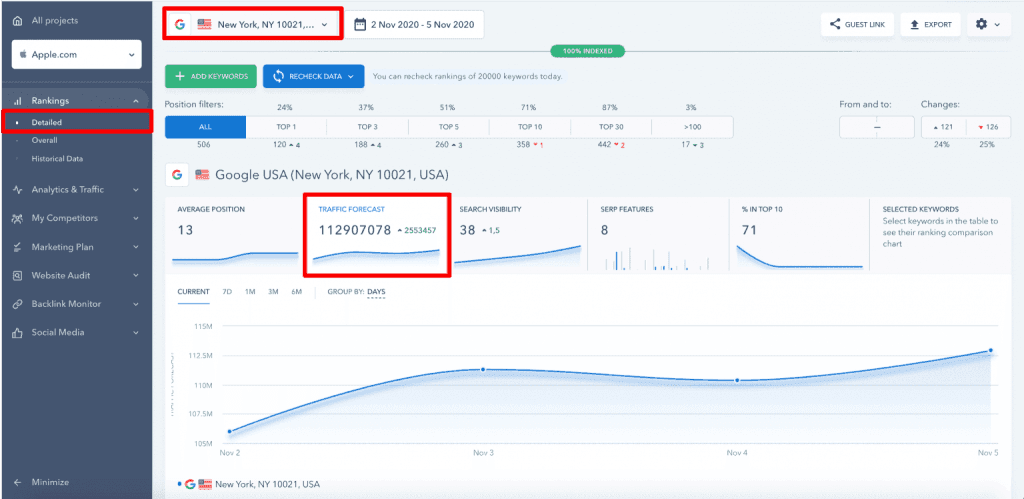
- Set Up Your Project: Input your target keywords and current rankings into SE Ranking’s Rank Tracker.
- Configure Conversion Settings: Set your conversion ratio and profit rate per client. For example, if 1 out of 50 visitors makes a purchase, set the conversion ratio to 1:50.
- Analyze Current Performance: Review your current traffic forecast, traffic cost, number of clients, and estimated income based on your current rankings.
- Forecast Future Performance: Use the “Estimated top” feature to predict traffic and leads for different ranking scenarios. Set it to “1” to see maximum potential.
- Estimate SEO Potential: The tool calculates expected traffic volume, traffic cost if acquired via Google Ads, and expected number of prospects.
- Compare with Competitors: Use SE Ranking’s competitor tracking feature to benchmark your forecasts against your rivals’ actual performance.
Pro Tip: Monitor and update your keyword data and rankings consistently. More historical data leads to more accurate forecasts and helps you track your SEO progress over time.
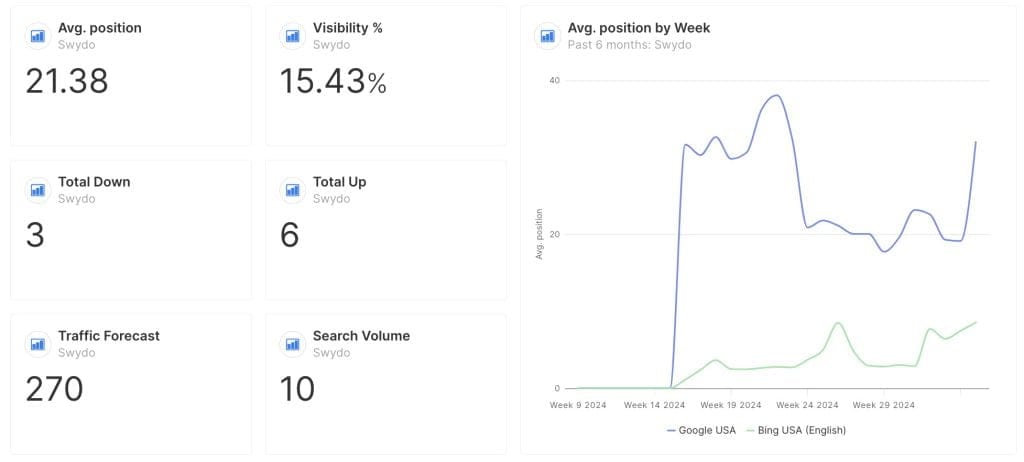
Keep in mind: These predictions serve as strategic guides, not guaranteed outcomes. Leverage them to justify ROI, optimize SEO budgets, and craft client estimates.
Apply Statistics for Future Insights
Use your historical data to predict future trends. Here’s a simple guide to get started:
1. Gather Your Data
Collect at least 12 months of data on:
- Organic traffic
- Rankings for key terms
- Conversions
- Major site changes or algorithm updates
2. Spot the Patterns:
Look out for:
- Seasonal ups and downs
- Day-of-week or time-of-day trends
- Results of past SEO efforts
3. Pick Your Statistical Weapon:
Popular choices include:
- Linear regression (great for steady growth trends)
- Exponential smoothing (perfect for seasonal data)
- ARIMA models (tackles complex time-series data)
Don’t sweat it if you’re not a stats guru. Tools like Google’s Colab or Excel can do the heavy lifting.
4. Interpret Your Result
Look for:
- Seasonal patterns
- Overall growth trends
- Unexpected spikes or drops
5. Refine Your Forecast
- Add more data as it becomes available
- Adjust for known future events (e.g., planned site changes)
- Consider external factors (e.g., market trends, competitor actions)
Python Method: How to Use This Python Code in Google Colab
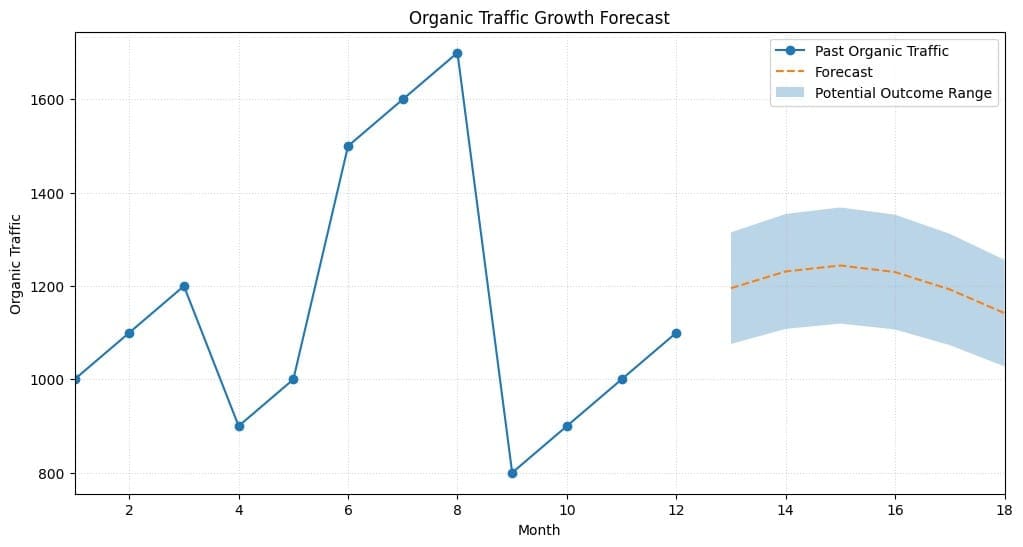
Without making you do all of the coding. I created a Python code using Linear Regression to create the forecast. Here’s how you can use it:
Open the Google Colab Link:
Make a Copy of the Notebook:
- Once the notebook is open, go to the top menu and click on File > Save a copy in Drive. This will create a copy of the notebook in their own Google Drive, allowing them to modify and run the code.
- Alternatively, they can click on File > Download .ipynb to download the notebook and upload it back into Colab later.
Run the Code:
- Once the copy is saved, they can run each code cell by clicking on the play button (or press Shift + Enter).
- When prompted, they can enter their monthly organic traffic data in the format
Month,Traffic(e.g.,1,1000;2,1200;3,1300). - The code will process the data and generate a forecast for the next 6 months.
View the Forecast:
- The notebook will display a chart showing both the historical data and forecasted traffic for the next 6 months.
- It will also print the forecasted traffic values, including a range for potential outcomes.
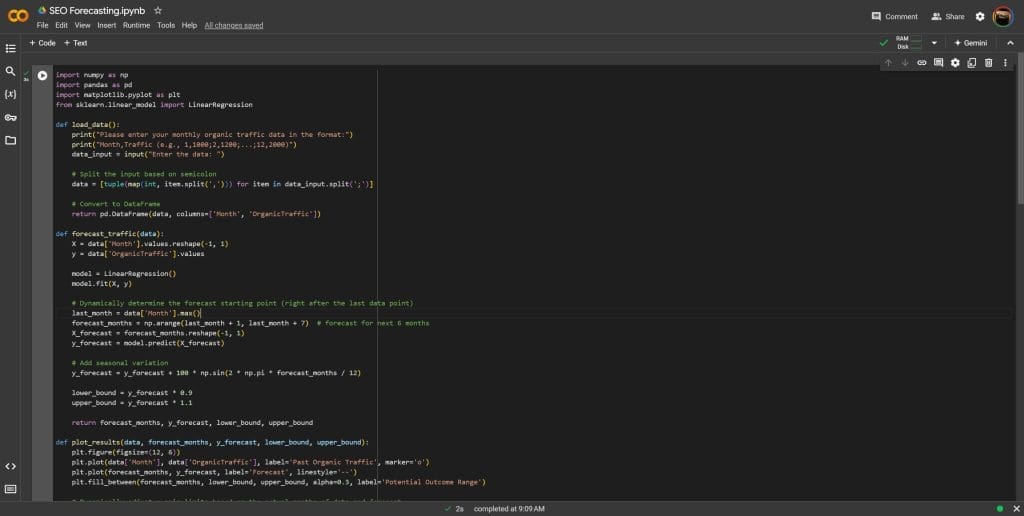
Pro Tip: Forecasts are guides, not guarantees. Use them to inform strategy, but be prepared to adapt as real-world data comes in.
4. Factor in the Wild Cards:
Think about:
- Planned site changes
- Potential algorithm updates
- Market trends in your client’s industry
Pro Tip: Give forecast ranges, not just one number. It sets realistic expectations and gives you wiggle room.
Beat the Competition with Smart Benchmarking
Use competitor data to set goals you can actually reach.
1. Spot the Real Rivals:
Look past who your client thinks they’re up against. Focus on who’s actually showing up in SERPs for their target keywords.
2. Dissect Competitor Performance:
Examine:
- Organic traffic (tools like SimilarWeb are gold for this)
- Keyword rankings
- Content strategies (type, frequency, quality)
- Backlink profiles

3. Find the Gaps and Opportunities:
Pinpoint where your client lags and where they shine. This reveals quick wins and long-term strategies.
4. Set Realistic Benchmarks:
Use competitor performance to set achievable goals. If the top dog gets 100,000 monthly organic visits, that’s a solid long-term target.
Pro Tip: Don’t obsess over industry giants. Analyze competitors on similar growth paths to your client. Their strategies often fit better and are more achievable.
Make Custom Forecasts with Google Sheets
Google Sheets is your Swiss Army knife for creating and sharing custom SEO forecasts. Follow this step-by-step guide to build a killer forecasting model:
1. Set the Stage in Your Spreadsheet:
Create a new Google Sheet with these columns:
A: Keyword
B: Current Rank
C: Search Volume
D: Current CTR
E: Forecasted Rank
F: Forecasted CTR
G: Current Traffic
H: Forecasted Traffic
I: Conversion Rate
J: Current Conversions
K: Forecasted Conversions
Google Sheets Forecast Example – Use this template and make a copy for your own forecasting model.

2. Import Data:
If you’re using Semrush, pull data directly with their API. You can read their guide on how to do that here.
Swap A2 with your keyword cell.
Heads up: You need a Semrush account, and it could hit rate limits for some users.
3. Calculate Current CTR:
Use this formula to estimate CTR based on current rank:
=IF(B2<=1, 0.3, IF(B2<=5, 0.1, IF(B2<=10, 0.05, IF(B2<=20, 0.01, 0))))
4. Compute Current Traffic:
Multiply search volume by current CTR:
=C2*D2
5. Predict Future CTR:
Use the same formula as step 3, but reference your forecasted rank:
=IF(E2<=1, 0.3, IF(E2<=5, 0.1, IF(E2<=10, 0.05, IF(E2<=20, 0.01, 0))))
6. Project Forecasted Traffic:
Multiply search volume by forecasted CTR:
=C2*F2
7. Figure Out Current and Forecasted Conversions:
Multiply traffic by conversion rate: Current: =G2*I2
Forecasted: =H2*I2
8. Create Eye-Catching Summary Stats:
You would place this summary section below your keyword forecasting table.
| Metric | Formula |
|---|---|
| Total Current Traffic | =SUM(G2) |
| Total Forecasted Traffic | =SUM(H2) |
| Traffic Increase | =H5-G5 |
| Percentage Traffic Increase | =IF(G5=0, 0, (H5-G5)/G5) |
| Total Current Conversions | =SUM(J2) |
| Total Forecasted Conversions | =SUM(K2) |
| Conversion Increase | =K5-J5 |
| Percentage Conversion Increase | =IF(J5=0, 0, (K5-J5)/J5) |
9. Make Your Data Pop with Visuals:
Create a bar chart comparing current and forecasted traffic:
- Select the Data Range:
- Highlight columns A (Keyword), G (Current Traffic), and H (Forecasted Traffic), but only the rows with data, such as A2, G2, and H2.
- Insert the Chart:
- Click Insert > Chart.
- In the Chart Editor, ensure the Chart Type is set to Bar Chart.
- Customize the Chart:
- Add titles for clarity, such as “Keyword Traffic Comparison.”
- Use different colors for current and forecasted traffic bars to make the chart visually distinct.
- Adjust axis labels if necessary.
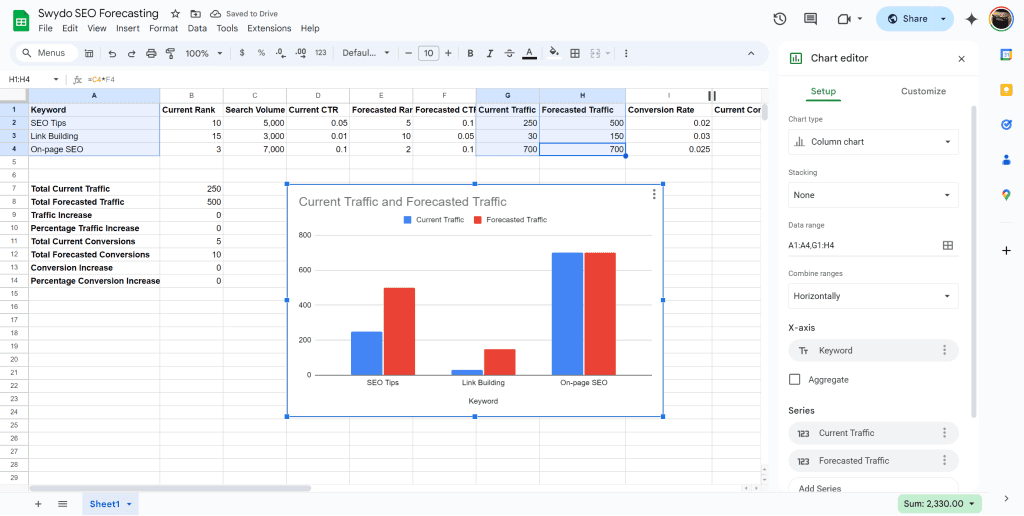
10. Plan for Different Scenarios:
To help predict traffic, we use a formula that estimates Click-Through Rate (CTR) based on your keyword’s forecasted rank in Google search results. The better the rank, the higher the chance people will click on your link. Here’s how the formula works:
=IF(E2<=1, 0.3, IF(E2<=5, 0.1, IF(E2<=10, 0.05, IF(E2<=20, 0.01, 0))))This may look complicated, but it’s pretty straightforward once you break it down:
- If your keyword ranks #1: The formula assigns a CTR of 30% (
0.3). - If your keyword ranks between #2 and #5: The formula assigns a CTR of 10% (
0.1). - If your keyword ranks between #6 and #10: The CTR drops to 5% (
0.05). - If your keyword ranks between #11 and #20: The CTR is only 1% (
0.01). - If your keyword ranks lower than #20, the CTR is 0.
This formula can help estimate how much traffic each keyword might get based on its forecasted rank. In each scenario (Best Case, Worst Case, Most Likely), you’ll tweak the forecasted rank in column E, and the formula will automatically adjust the forecasted CTR.
Example:
- In the Best Case scenario, where you expect a keyword to rank #1, the formula will give it a 30% CTR.
- In the Worst Case scenario, where you think the keyword might only rank #15, the CTR drops to 1%.
- In the Most Likely scenario, if the keyword ranks around #5, the CTR will be 10%.
This helps you create realistic traffic forecasts and better manage client expectations.

How to Apply It:
- Step 1: Create three tabs: “Best Case,” “Worst Case,” and “Most Likely.”
- Step 2: Copy your forecast model to each tab.
- Step 3: In each tab, adjust the forecasted ranks in column E based on the scenario.
- Best Case: Optimistic ranks (e.g., #1).
- Worst Case: Pessimistic ranks (e.g., #15).
- Most Likely: Realistic ranks (e.g., #5).
- Step 4: The forecasted CTR in column F will automatically adjust based on the rank, giving you a new forecasted traffic and conversion estimate.
When you use these different scenarios, you can demonstrate strategic thinking and manage expectations with clients.
11. Run a Sensitivity Analysis:
A Sensitivity Analysis helps you test how different factors, like changes in Click-Through Rate (CTR) or conversion rates, could affect your forecast. It allows you to see how sensitive your traffic and conversion predictions are to changes in these assumptions.
How to Set It Up:
- Create a New Tab:
- In your Google Sheet, make a new tab called “Sensitivity Analysis”. This will hold different CTR and conversion rate assumptions based on various ranks.
- Set Up a Table of Assumptions:
- In the new tab, create a table that lists possible CTR and conversion rates for different ranks. For example:
| Rank | CTR | Conversion Rate |
|---|---|---|
| 1 | 0.30 | 0.03 |
| 2 | 0.25 | 0.028 |
| 3 | 0.20 | 0.025 |
| 4 | 0.15 | 0.022 |
| 5 | 0.10 | 0.02 |
| 6-10 | 0.05 | 0.015 |
| 11-20 | 0.01 | 0.01 |
This table shows how CTR and conversion rates change based on where a keyword ranks. For example, a keyword ranking #1 has a 30% CTR and a 3% conversion rate, while a keyword ranking #15 might have a 1% CTR and a 1% conversion rate.
- Use the VLOOKUP Function:
- Now, we use the VLOOKUP function to automatically pull these values into your forecast.In your main forecast model, use the following formula to get the conversion rate based on the forecasted rank:
=VLOOKUP(E2, 'Sensitivity Analysis'!$A$2:$C$10, 3, TRUE)- Here’s what this formula does:
- E2: Looks at the forecasted rank of the keyword.
- ‘Sensitivity Analysis’!$A$2:$C$10: Searches for that rank in the Sensitivity Analysis tab.
- 3: Returns the conversion rate from the 3rd column of the Sensitivity Analysis table.
- TRUE: Allows the function to match rank ranges (e.g., for ranks like 6-10 or 11-20).
What This Achieves:
This sensitivity analysis gives you the flexibility to model different assumptions and see how they affect the forecast. For example, if your conversion rate assumptions change, the forecasted traffic and conversions will adjust automatically. It’s a great way to show clients potential outcomes based on different scenarios.
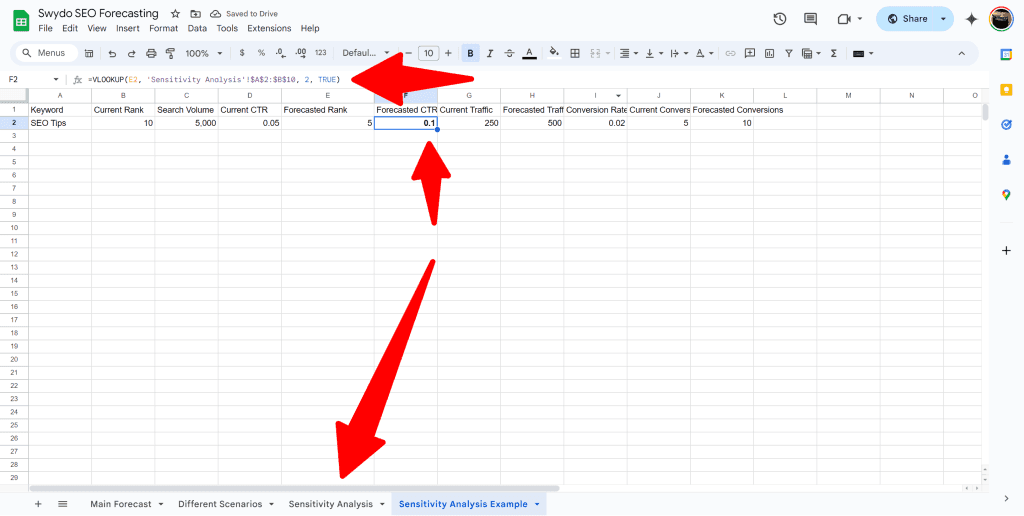
Power User Tips Ideas:
- Use conditional formatting to highlight big changes or opportunities
- Set up data validation for the “Forecasted Rank” column to keep predictions realistic
- Pull in industry-specific data with the GOOGLEFINANCE function for more accurate forecasts
Keep your ranking and traffic data fresh to boost forecast accuracy over time. This model is your starting point – customize and expand it to fit your unique needs and data sources.
Advanced Strategies to Take Your Forecasting to the Next Level
Set your agency apart with these advanced techniques. They’ll boost your forecasting game and impress your clients.
Customize Your Approach for Each Client
Ditch the one-size-fits-all mindset in SEO forecasting. Each client brings unique circumstances, goals, and challenges. Excel by tailoring your approach to key factors:
- Business model (e-commerce, lead generation, branding)
- Industry (B2B vs B2C, local vs national)
- SEO maturity
- Available resources and budget
Create a “forecasting questionnaire” to quickly grasp a client’s unique situation. This saves time and showcases your expertise.
| Factor | Questions to Ask |
|---|---|
| Business Model | What’s your primary revenue source? |
| How do customers typically find you? | |
| Industry | Who are your main competitors? |
| What are the key seasonal trends? | |
| SEO Maturity | What SEO efforts have you tried before? |
| What’s your current organic traffic? | |
| Resources | What’s your monthly SEO budget? |
| Do you have in-house content creators? |
Integrate SEO with Other Marketing Channels
SEO doesn’t exist in isolation. Consider how it interacts with other channels:
- PPC: Use high-performing paid keywords for organic optimization.
- Social Media: Factor in viral content’s impact on brand searches and backlinks.
- Content Marketing: Include planned initiatives in your SEO forecasts.
This holistic approach positions you as a strategic partner, not just an SEO specialist.
Tell a Story with Your Data
Data alone isn’t enough. Use storytelling to make your forecasts compelling and actionable:
- Choose the right visualization tools (e.g., Tableau, Looker Data Studio, Swydo).
- Provide context and explanations, not just numbers.
- Structure reports to tell a story:
[Table: Report Structure]
| Section | Content |
|---|---|
| Executive Summary | Overall performance at a glance |
| Wins and Challenges | Specific areas of success and concern |
| Detailed Metrics | In-depth look at key KPIs |
| Action Items | Next steps based on the data |
Make your client’s job easier with clear, impactful SEO reports they can easily share with higher-ups.
Key Takeaway: Trust, Results, and Growth
SEO forecasting goes beyond number prediction. Build trust with clients and deliver measurable results. Transform your role from “vendor” to trusted growth partner.
Excel at SEO forecasting to stand out in a crowded market. Change client conversations from “What can you do for us?” to “How soon can we start?”
Perfection isn’t the goal. Provide a clear, data-driven roadmap to help clients understand SEO value and your work’s impact. Set realistic expectations, then exceed them.
